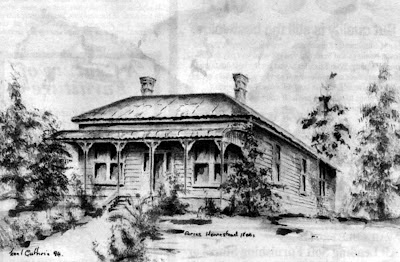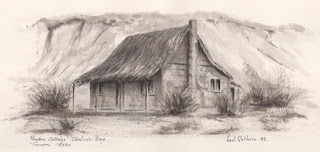Grandfathers Dream
Grandfathers
Dream
Any visitor to the Mackenzie and of course
those who turn of Main Highway 8 at Burkes Pass, on to the Rollesby Valley
Road, will be surprised at the expanse of open fertile country, stretching down
to the Mackenzie Pass and beyond, to where, as history records, was where one
of New Zealand’s notorious sheep stealer was allegedly captured.
However, that is a story for another time.
This little feature is about my
grandfather’s dream.
I had always had a vague idea where my
grandfather had originally launched into his ultimate dream of developing a
flock of crossbred sheep, suited to the smaller yet more manageable acreage of
the Mackenzie Basin, but had never ventured there.
 |
| Original Airies Homestead A copy of a watercolour sketch by Noel Guthrie |
Mark, my son took me on a little jaunt up
into the area one day, not so long ago, to where my grandparents in the 1800s,
built their first homestead in the Mackenzie Country. There are no formed tracks into the site now of course, but we
turned off the Rollesby Valley Road, about half way between Burkes Pass and Mackenzie
Pass, and literally headed for the hills, traversing eastward across rolling
country between the road and the actual site.
What a view it turned out to be, from the
base of those eastern slopes of Rollesby Valley. Those old pioneers obviously
had a few clues as to the most suitable and sheltered position where they could
put down roots.
From this sheltered spot, I could see
across the valley, maybe ten kilometres or more and on to an uninterrupted view
of those snow capped peaks along the Southern Alps.
I took some photographs of what is
remaining of that original homestead, a couple of stubby concrete foundations,
of which I was able to establish the outline of part of my ancestry. As one becomes a little older, family
history seems to have more meaning. We
never had time for that when we were younger, too busy raising our own families
I suppose.
Getting back to grandfathers dream though,
he had obviously planted a great number of trees to act as shelter along the
steep faces behind the house and to the south.
Now of course, having succumbed to the saw miller, those trees are
nothing more than rotting pine stumps, which disappear into the middle distance
beneath a carpet of shimmering golden high country pasture.
It is over 130 years since my grandfather
came to the Mackenzie. Like a great
number of those early settlers into this portion of New Zealand, my
grandfather, Robert Guthrie, was a true blue Scot. He had entered University in Scotland to take up a degree in
law. However, as with that profession,
his days were spent indoors and to the detriment of his health. In an effort to improve his circumstances,
he travelled to Canada, but was soon to return. At that point, he must have decided to travel to New Zealand
aboard the sailing vessel ‘Corlic’ in 1876 and put down roots in the
Mackenzie.
One thing in Robert’s favour was that he
possessed a strong love of nature and enjoyed the rugged surroundings of the
Mackenzie landscape; it so reminded him of his homeland.
So, for almost the next 20 years, his law
degree and university education assisted him as he managed a number of high
country sheep runs throughout the Mackenzie.
At first he spent four years managing the
Wolds Run, which lay between Irishman Creek and Simons Pass, on the western
side of the Tekapo River.
For the three years following, he took up
management of the Blainslie Run in the Albury district. It was during this term at Blainslie, that
Robert married Catherine.
In 1883, at the request of the Rutherford
brothers, John, Robert and Edmund, my grandfather was appointed as manager of
the Mistake Station, (now known as Godley Peaks), at the head of Lake Tekapo,
where Robert and Catherine spent the next ten years of their life.
It was during their time at the Mistake
Station, grandfather had this dream. He
saw the greater possibilities for growth in the Mackenzie. With the prospect of closer settlement of
this regions more accessible country, he became one of the first high
countrymen to put his dream into practice.
In 1893, part of the greater ‘Three Springs
Run’, which stretched from the western side of Fairlie to Burkes Pass, the
Government subdivided part of this for closer settlement. Robert and Catherine tendered their interest
and were the successful applicants for a block between Burkes Pass and Kimbell,
a block they subsequently named Airies.
This name probably originating from Roberts home province, ‘Ayrshire’,
back in Scotland.
One year later in 1894, two more blocks
came up, namely Single Hill and Knobbies were subdivided off the neighbouring
Rollesby Run. Donald McLeod took both
these lots. However, he soon relinquished the Knobbies piece to Robert and
Catherine, who incorporated it into the Airies Run and stocked it with around
4000 head of crossbred sheep. It
appears it was the Knobbies block, where Robert and Catherine decided to build.
It was that strong love of nature and of
the environment, which Robert became recognized as quite an authority in all
branches of the pastoral association, and became a member of the Agricultural
and Pastoral Society.
Of course, being a Scot, there was only one
recognized form of music, the bagpipes, so I suppose it was natural enough for
him to become one of the founding members of the Mackenzie Caledonian Society.
Robert seemed to like becoming involved in
community affairs and soon concerned himself with the Burkes Pass School
Committee. Well, of course with 14
kids, he was going to be involved for some time.
For a period of time, Robert was a member
of the Mackenzie County Council, officially known as the Mackenzie Roads Board,
at the time when the Offices, was located at Burkes Pass.
Robert and Catherine moved off Airies,
selling out to A. G. Alder, and became city dwellers in Timaru shortly before
1920. However his retirement was
short-lived and he passed away within a short time.
Airies passed on to P. P. Hudson during the
1940s, before H.A.Munro took control in 1950, the family retaining title even
to this day.
It was during the Munros’ tenancy, that
grandfathers first homestead succumbed to the ravages of a violent nor-west
gale. Obviously it had not been
occupied for some time, but never the less, it is sad to see part of a family
heritage disappear in just a little puff of wind, so to speak.
Thank you for reading my blog, hope you enjoyed it.
Have a nice day.
Noel G


Comments
Post a Comment